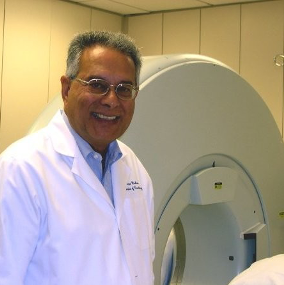
Nizar A. Mullani
June 26, 2023 — Nizar A. Mullani, one of the pioneers of the first positron emission tomography (PET) prototype, has been named as this year’s recipient of the Georg Charles de Hevesy Nuclear Pioneer Award. Mullani was presented the award by the Society of Nuclear Medicine and Molecular Imaging (SNMMI) at its 2023 Annual Meeting.
Mullani, partner at 3Gen, LLC, and president of Translite, LLC, is recognized for his significant contribution to the development of positron emission tomography. Along with colleagues Michel Ter-Pogossian, Michael E. Phelps, Edward J. Hoffman, Mullani worked day and night on a shoestring budget to develop a series of prototype tomographic PET scanners from which today’s clinical systems are directly descended. Mullani contributed to new innovations in PET designs including multi-slice scanners and fast scanners using Cesium Fluoride detectors, and he published the first validation of the use of time-of-flight information in PET to improve image quality. His expertise in engineering physics also led to the creation of several other medical inventions, including DermLite and Veinlite.
“The scope of Nizar’s work throughout his career is formidable,” said SNMMI president Munir Ghesani, MD, FACNM, FACR. “Not only was he involved with the invention of PET as we know it today, but also he has contributed to countless other advances that are now used on a daily basis, allowing innovative and safer practice of medicine and benefitting thousands of patients every day.”
Mullani received a bachelor’s degree in engineering physics from Washington University in St. Louis, Missouri, in 1969. He remained at Washington University Medical School in St. Louis, Missouri, as a research associate until 1980, after which he moved to the University of Texas Medical School in Houston, Texas, to serve as assistant professor and director of PET instrumentation. After retiring as associate professor in 2004, Mullani pursued the application of optical imaging for skin cancer and vein detection and developed DermLite and Veinlite.
In addition to these roles, Mullani has served as an associate editor of the American Journal of Physiological Imaging, as well as a reviewer for The Journal of Nuclear Medicine, Transactions Nuclear Science, and the Journal of Computer Assisted Tomography. He also served on the Member Site Visit Review Committee for the National Institutes of Health and the U.S. Department of Energy. Mullani is a member of the SNMMI, the Institute of Electrical and Electronics Engineers Nuclear Science Society, and the American Association for the Advancement of Science.
“I am humbled to have received the SNMMI de Hevesy Award,” said Mullani. “I have had the pleasure of working with so many amazing colleagues throughout my career and am proud of the work we have accomplished to improve medical care for patients around the world. The potential for advances in nuclear medicine is endless, and I look forward to seeing how the field will evolve in the future.”
Each year, SNMMI presents the Georg Charles de Hevesy Nuclear Medicine Pioneer Award to an individual for outstanding contributions to the field of nuclear medicine. De Hevesy received the 1943 Nobel Prize in chemistry for his work in determining the absorption, distribution, metabolism and elimination of radioactive compounds in the human body. His work led to the foundation of nuclear medicine as a tool for diagnosis and therapy, and he is considered the father of nuclear medicine. SNMMI has given the de Hevesy Award every year since 1960 to honor groundbreaking work in the field of nuclear medicine.
The list of previous recipients of this award includes numerous Nobel laureates—such as Ernest Lawrence, who built the world’s first cyclotron for the production of radionuclides, and Glenn Seaborg, who discovered more than half a dozen new elements.
For more information: www.snmmi.org


 November 18, 2025
November 18, 2025 









